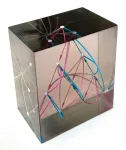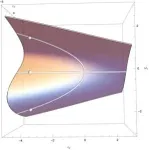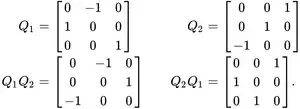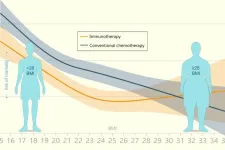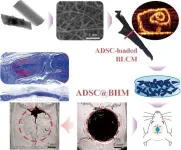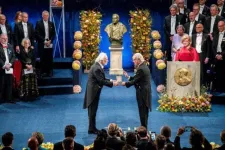(Press-News.org) Several fields of mathematics have developed in total isolation, using their own ‘undecipherable’ coded languages. In a new study published in PNAS, Tamás Hausel, professor of mathematics at the Institute of Science and Technology Austria (ISTA), presents “big algebras,” a two-way mathematical ‘dictionary’ between symmetry, algebra, and geometry, that could strengthen the connection between the distant worlds of quantum physics and number theory.
Technical Toolkit: Symmetry and commutativity, from esthetics to functionality
Symmetry is not just a question of esthetics and equilibrium, but also a highly recurrent feature throughout the domains of life. Mathematically, symmetry is a form of ‘invariance’: Even when subjected to certain operations or transformations, a symmetrical mathematical object remains unchanged.
The group of all transformations under which a mathematical object remains invariant is called a ‘symmetry group.’
Symmetries such as the rotation of a circle or a sphere can be classified as ‘continuous.’ (Contrary to this, an example of a ‘discrete’ symmetry is the mirroring of a bilaterally symmetrical object like a butterfly’s wings.)
Continuous symmetry groups are mathematically represented by matrices—rectangular arrays of numbers—which can convert the properties of the mathematical object into linear algebra.
Continuous symmetry groups are called ‘commutative’ when the order of the operations or transformations does not matter, or ‘non-commutative’ in the opposite case.
Rotations of a circle can be seen as a commutative continuous symmetry group. In contrast, the symmetry group of the planet Earth is non-commutative: if one starts by looking at the equator going through Africa, rotating left then down does not produce the same result as rotating down then left. In the first case, one’s view would be centered on the South Pole. In the second, one would arrive at the equator in the western hemisphere with the poles positioned horizontally.
Non-commutative symmetry groups have been so far represented by non-commutative matrices, i.e., matrices in which the order of operations influences the end result. However, this does not allow a geometric interpretation as the geometry of non-commutative algebras is not yet well understood. On the other hand, commutative algebras can be well understood through their geometry.
A “big algebra” is a commutative ‘translation’ of a non-commutative matrix algebra, and thus allows the use of algebraic geometry techniques. As a result, big algebras shed new light on the properties of non-commutative continuous symmetry groups.
Mathematics, the most exact among scientific disciplines, could be viewed as the ultimate quest for absolute truth. However, the mathematical roads to truth often need to overcome tremendous obstacles, much like conquering unimaginably high mountain peaks or building giant bridges between isolated continents. The mathematical world abounds with mysteries and several mathematical disciplines have developed along convoluted paths—in complete isolation from one another. Thus, establishing an irrefutable truth around complex phenomena in the physical world draws on intuition and a good deal of abstraction. Even fundamental aspects of physics push mathematics to new heights of complexity. This is especially true for symmetries, with the help of which physicists have theorized and discovered an entire zoo of subatomic particles that make up our universe.
In an exceptionally ambitious endeavor, Tamás Hausel, professor at the Institute of Science and Technology Austria (ISTA), not only conjectured but also proved a new mathematical tool called “big algebras.” This new theorem is comparable to a ‘dictionary’ that deciphers the most abstract aspects of mathematical symmetry using algebraic geometry. By operating at the intersection of symmetry, abstract algebra, and geometry, big algebras use more tangible geometric information to recapitulate sophisticated mathematical information about symmetries. “With big algebras, information from the ‘tip of the mathematical iceberg’ can give us unprecedented insights into the hidden depths of the mysterious world of symmetry groups,” says Hausel. With this mathematical breakthrough, Hausel seeks to consolidate the connection between two distant fields of mathematics: “Imagine, on the one hand, a world of mathematical representations of quantum physics, and on the other hand, very, very far away, the purely mathematical world of number theory. With the present work, I hope to have come one step closer to establishing a stable connection between these two worlds.”
No longer lost in translation
The 17th-century philosopher and mathematician René Descartes showed us that we could understand the geometry of objects by using algebraic equations. Thus, he was the first to ‘translate’ mathematical information between these previously separate fields. “I like to view the relations between different mathematical fields as dictionaries that translate information between often non-mutually intelligible mathematical languages,” says Hausel. So far, several such mathematical ‘dictionaries’ have been developed, but some only translate the information in one direction, leaving the information about the way back entirely encrypted. Furthermore, the term “algebra” nowadays encompasses both classical algebra, as in Descartes’ time, and abstract algebra, i.e. the study of mathematical structures that cannot necessarily be expressed with numerical values. This adds another layer of complexity. Now, Hausel uses abstract algebra and algebraic geometry as a two-way ‘dictionary’.
A skeleton and nerves
In mathematics, symmetry is defined as a form of ‘invariance’. The group of transformations that keep a mathematical object unchanged is called a “symmetry group”. These are classified as ‘continuous’ (e.g., the rotation of a circle or sphere) or ‘discrete’ (e.g., the mirroring of an object). Continuous symmetry groups are represented mathematically by matrices—rectangular arrays of numbers. Starting from a matrix representation of a continuous symmetry group, Hausel can compute the big algebra and represent its essential properties geometrically by drawing its ‘skeleton’ and ‘nerves’ on a mathematical surface. The big algebra’s skeleton and nerves give rise to interesting, 3D-printable shapes that recapitulate sophisticated aspects of the original mathematical information, thus closing the translation circle. “I am particularly excited about this work, as it provides us with a completely novel approach to studying representations of continuous symmetry groups. With big algebras, the mathematical ‘translation’ does not only work in one direction but in both.”
Bridging isolated continents in a vast world of mathematics
How could big algebras strengthen the link between quantum physics and number theory, two fields of mathematics seemingly worlds apart? Firstly, the math behind quantum physics makes extensive use of matrices—rectangular arrays of numbers. However, these matrices are typically ‘non-commutative,’ meaning that multiplying the first matrix by the second does not yield the same result as multiplying the second one by the first. This poses a problem in algebra and algebraic geometry as non-commutative algebra is not yet well understood. Big algebras now solve this problem: when computed, a big algebra is a commutative ‘mathematical translation’ of a non-commutative matrix algebra. Thus, the information initially enclosed within non-commutative matrices can be decoded and represented geometrically to reveal their hidden properties.
Secondly, Hausel shows that big algebras not only reveal relationships between related symmetry groups, but also when their so-called “Langlands duals” are related. These duals are a central concept in the purely mathematical world of number theory. In the Langlands Program, a highly intricate, large-scale dictionary that seeks to bridge isolated mathematical ‘continents,’ the Langlands duality is a concept or tool that allows ‘mapping’ mathematical information between different categories. “In my work, big algebras seem to relate different symmetry groups precisely when their Langlands duals are related, a quite surprising outcome with possible applications in number theory,” says Hausel.
“Ideally, big algebras would allow me to relate the Langlands duality in number theory with quantum physics,” says Hausel. For now, he was able to demonstrate that big algebras solve problems on both of these continents. The fog has started to dissipate, and the continents of quantum physics and number theory have caught a glimpse of each others’ mountains and shores on the horizon. Soon, rather than only connecting the continents by boat, a bridge of big algebras might allow an easier crossing of the mathematical strait separating them.
END
Big algebras: A dictionary of abstract math
Abstract algebra and algebraic geometry to connect quantum physics with number theory
2024-09-12
ELSE PRESS RELEASES FROM THIS DATE:
BMI’s relation to cancer therapy mortality risks not so straightforward
2024-09-12
While being overweight increases the risk of developing lifestyle-related diseases, there is a phenomenon known as the obesity paradox where a decreased risk of death has been seen during cancer therapy. However, that paradox might not be the trend for all cancer therapies, an Osaka Metropolitan University team reports in JAMA Network Open, a publication of the American Medical Association.
Led by graduate student Mr. Yasutaka Ihara and Professor Ayumi Shintani of the Graduate School of Medicine’s Department of Medical Statistics, ...
Kids in families with too much screen time struggle with language skills
2024-09-12
Screens have become ubiquitous in our daily lives — which means they’ve also become part of children’s lives too. So what effect does this have on children’s developing brains, especially critical language skills? To understand this, scientists in Estonia surveyed the parents of more than 400 children about their screen use, their children’s screen use, and their children’s language skills. They found that parents who use screens a lot also have children who use screens a lot, and that children’s higher screen time is associated with poorer language skills.
“Our ...
Medical College of Georgia scientists searching for new treatment target for diabetic retinopathy
2024-09-12
Scientists at the Medical College of Georgia at Augusta University are searching for a new treatment target for a common complication of diabetes that can cause retinal blood vessels to break down, leak, or become blocked.
Diabetic retinopathy is a serious eye disease and a leading cause of blindness that results when diabetes’ sustained high blood sugar levels cause damage to the retina – the part of the eye that detects light – over time. That can happen in a number of ways, from inflammation to overgrowth ...
High doses of some prescription stimulants tied to increased psychosis risk
2024-09-12
Prescribing rates for stimulants that treat attention-deficit/hyperactivity disorder (ADHD) have increased significantly over the past decade, with some of the largest increases reported during the COVID-19 pandemic. A new study of adult emergency department admissions at Mass General Brigham, led by McLean Hospital researchers, found that individuals who are taking high doses of amphetamine (e.g. Adderall) face more than a five-fold increased risk for developing psychosis or mania. Findings were published September 12th in the American Journal of Psychiatry.
Overall, individuals with past-month prescription amphetamine use had a greater likelihood of new-onset psychosis or mania ...
New national survey shows hesitancy about vaccines this fall
2024-09-12
With flu season just around the corner and COVID-19 cases on the rise, a new nationwide survey from The Ohio State University Wexner Medical Center reveals hesitancy around vaccines this fall. The new data comes just as this year’s flu shot rolls out and following the FDA’s approval of an updated round of COVID-19 vaccines.
The national poll of 1,006 people found more than one-third (37%) have gotten vaccines in the past but do not plan to this year. The same percent of respondents said they don’t need any of the vaccines surveyed in the poll, including flu, COVID-19, pneumococcal and respiratory ...
Revolutionary tubular scaffolds boost stem cell-driven bone regeneration in skull defects
2024-09-12
Scientists from Sun Yat-sen University's School of Biomedical Engineering have developed groundbreaking tubular scaffolds made from electrospun membranes, which significantly enhance bone regeneration in critical skull defects. These scaffolds, designed to mimic natural bone structures, create an ideal environment for adipose-derived stem cells (rADSCs) to thrive and accelerate healing. By integrating advanced materials like polycaprolactone, PLGA, and nano-hydroxyapatite, the researchers achieved remarkable results in both lab and animal studies, ...
UTokyo attosecond institute welcomes Nobel laureate
2024-09-12
Nobel laureate Pierre Agostini, winner of the 2023 prize in physics, will headline a special two-day event hosted by the University of Tokyo on Sept. 26-27. The keynote lecture by Agostini, renowned for this pioneering work in attosecond science, will be part of a larger symposium bringing together researchers from around the world to celebrate the university’s planned Attosecond Laser Facility (ALFA), and discuss the latest developments and future directions of attosecond science.
Have you taken a photo of a fast-moving animal or vehicle and noticed how blurry the subject can be? This is likely because the faster a moving subject is, the faster the camera’s shutter needs ...
Single dose of mpox vaccine effective in preventing infection, study finds
2024-09-11
Toronto, ON, September 11, 2024 — A single dose of the Modified vaccinia Ankara-Bavarian Nordic (MVA-BN) was 58% effective in protecting again mpox infection, according to a new study published in BMJ.
Researchers from ICES, Public Health Ontario, and the MAP Centre for Urban Health Solutions at St. Michael’s Hospital of Unity Health Toronto have conducted a target trial emulation to estimate the effectiveness of the mpox vaccine.
During the mpox outbreak in 2022, Ontario, Canada introduced the vaccine ...
One dose of smallpox vaccine moderately effective in preventing mpox infection
2024-09-11
One dose of modified vaccinia Ankara-Bavarian Nordic (MVA-BN) smallpox vaccine is moderately effective in preventing mpox infection and should be made available to communities at risk, finds a study published by The BMJ today.
With mpox infections rising again across the globe, the researchers say these findings “strengthen the evidence that MVA-BN is effective at preventing mpox infection and should be made available and accessible to communities at risk.”
No randomised clinical trials of vaccination against mpox have been conducted. Estimates of the effectiveness of a single dose of vaccination from observational studies range from ...
More than half of UK government nutrition advisors are paid by food companies
2024-09-11
More than half of the experts on the UK government’s nutrition advisory panel have links to the food industry, reveals an investigation by The BMJ today.
At least 11 of the 17 members of the Scientific Advisory Committee on Nutrition (SACN) have conflicts of interest with the likes of Nestle, sugar manufacturer Tate and Lyle, and the world’s largest ice cream producer, Unilever, reports freelance journalist Sophie Borland.
And at least six out of the 11 members of SACN’s Subgroup on Maternal and Child Nutrition have ties to food firms, including baby food manufacturers and formula milk brands.
SACN ...
LAST 30 PRESS RELEASES:
How talking slows eye movements behind the wheel
The Ceramic Society of Japan’s Oxoate Ceramics Research Association launches new international book project
Heart-brain connection: international study reveals the role of the vagus nerve in keeping the heart young
Researchers identify Rb1 as a predictive biomarker for a new therapeutic strategy in some breast cancers
Survey reveals ethical gaps slowing AI adoption in pediatric surgery
Stimulant ADHD medications work differently than thought
AI overestimates how smart people are, according to HSE economists
HSE researchers create genome-wide map of quadruplexes
Scientists boost cell "powerhouses" to burn more calories
Automatic label checking: The missing step in making reliable medical AI
Low daily alcohol intake linked to 50% heightened mouth cancer risk in India
American Meteorological Society announces Rick Spinrad as 2026 President-Elect
Biomass-based carbon capture spotlighted in newly released global climate webinar recording
Illuminating invisible nano pollutants: advanced bioimaging tracks the full journey of emerging nanoscale contaminants in living systems
How does age affect recovery from spinal cord injury?
Novel AI tool offers prognosis for patients with head and neck cancer
Fathers’ microplastic exposure tied to their children’s metabolic problems
Research validates laboratory model for studying high-grade serous ovarian cancer
SIR 2026 delivers transformative breakthroughs in minimally invasive medicine to improve patient care
Stem Cell Reports most downloaded papers of 2025 highlight the breadth and impact of stem cell research
Oxford-led study estimates NHS spends around 3% of its primary and secondary care budget on the health impacts of heat and cold in England
A researcher’s long quest leads to a smart composite breakthrough
Urban wild bees act as “microbial sensors” of city health.
New study finds where you live affects recovery after a hip fracture
Forecasting the impact of fully automated vehicle adoption on US road traffic injuries
Alcohol-related hospitalizations from 2016 to 2022
Semaglutide and hospitalizations in patients with obesity and established cardiovascular disease
Researchers ‘listen in’ to embryo-mother interactions during implantation using a culture system replicating the womb lining
How changing your diet could help save the world
How to make AI truly scalable and reliable for real-time traffic assignment?
[Press-News.org] Big algebras: A dictionary of abstract mathAbstract algebra and algebraic geometry to connect quantum physics with number theory
